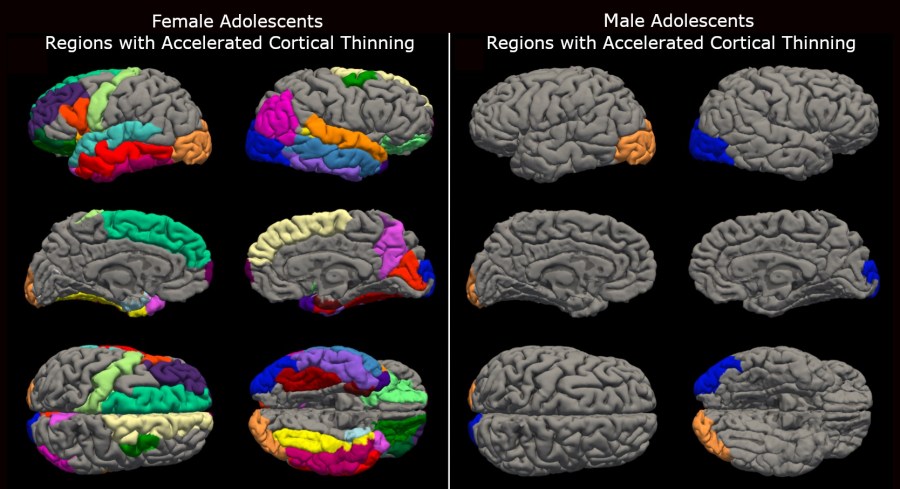Related video: Endemic vs. Epidemic vs. Pandemic
(NEXSTAR) – A new study comparing the brains of children before and after COVID-19 found that adolescent girls’ brains had aged faster than expected during the social isolation and lockdowns brought on by the pandemic.
University of Washington researchers behind the study – published Monday in the Proceedings of the National Academy of Sciences – used magnetic resonance imaging (MRI) to study the brain structure of 160 subjects ranging in age from 9 to 17.
“We think of the COVID-19 pandemic as a health crisis,” said Patricia Kuhl, senior author and co-director of the UW Institute for Learning & Brain Sciences (I-LABS), in a University of Washington article, “but we know that it produced other profound changes in our lives, especially for teenagers.”
The initial goal of the study when the first scans were performed in 2018 was to examine brain changes during typical adolescence, and a second scan was scheduled for 2020. The COVID-19 pandemic lockdowns made that impossible, however, so researchers were forced to wait another year.
When they finally got the second round of MRI results in 2021, the team noticed a “stunning difference,” Patricia K. Kuhl, study co-author and director of the Institute for Learning and Brain Sciences at the University of Washington, told The New York Times.
As the human brain matures, the cerebral cortex, or the outer layer of tissue in the brain, naturally starts to thin, even among teenagers.
Such thinning can happen faster, however, under “chronic stress and adversity,” and is linked to a higher risk of disorders that include anxiety and depression, especially among females, the researchers said.
“We know that in adult women with anorexia nervosa, cortical atrophy or brain thinning correlates with starvation,” Dr. Ellen S. Rome, head of Cleveland Clinic’s Center for Adolescent Medicine, told Nexstar.
“We saw such a rise of disordered eating in the pandemic and beyond; future research can help tease out whether this study reflects that increase in eating disorders in girls during the pandemic versus some other factors,” added Rome, who was not involved in the study.
Results of the 2021 scans, which followed a historic, prolonged period of social isolation, suggested that “a girl who came in at 11, and then returned to the lab at age 14, now has a brain that looks like an 18-year-old’s,” Kuhl told The Times. The average amount of aging in females was 4.2 years, with 1.4 years in males.
Previous studies have documented accelerated brain aging in teens who experienced the pandemic lockdowns, but those did not examine differences by sex, according to the UW research team.
The rapid thinning was seen all over the brains of females, but only in the visual cortex for males, suggesting that developing girls may rely more on personal relationships, the ability to gather and the opportunity to talk and share feelings, according to Kuhl.
“Teenagers really are walking a tightrope, trying to get their lives together,” Kuhl said. “They’re under tremendous pressure. Then a global pandemic strikes and their normal channels of stress release are gone. Those release outlets aren’t there anymore, but the social criticisms and pressures remain because of social media. What the pandemic really seems to have done is to isolate girls. All teenagers got isolated, but girls suffered more. It affected their brains much more dramatically.”
With lockdowns lifted and children back in classrooms, it remains to be seen how the subjects’ brains will react, but Kuhl says it’s unlikely there will be any cortical thickening, however, the thinning process may slow down over time.
“It is possible that there might be some recovery,” Kuhl said. “On the other hand, it’s also possible to imagine that brain maturation will remain accelerated in these teens.”
The study is not without limitations, however. In an email to CNN, Dr. Max Wiznitzer, professor of pediatrics and neurology at the Case Western Reserve University School of Medicine pointed out that the research team didn’t have a true control group of teens unaffected by the pandemic, because everyone was. Wiznitzer added that the study didn’t provide data on other aspects of the subjects lives, such as food security, economic resources, sleep habits or diets, among other factors. It’s also not clear which children caught the coronavirus during those years, and how that might have affected the brain.
The MRI scans were also taken from different subsets before and after the pandemic, Dr. Bradley Peterson, pediatric psychiatrist and brain researcher at Children’s Hospital Los Angeles pointed out to U.S. News and World Report. Because of this, its impossible to track brain changes in individuals involved in the study, Bradley said.
He added that there was “no supporting evidence” that the brain aging was caused solely by social isolation and not by social media use, an increase in screen time, a lack of physical exercise or an overall spike in COVID-related stress during the pandemic.
Kuhl acknowledged that future studies are needed to understand the full extent of the pandemic’s impact on teenagers’ brains.
“Our research introduces a new set of questions about what it means to speed up the aging process in the brain,” Kuhl said. “All the best research raises profound new questions, and I think that’s what we’ve done here.”
